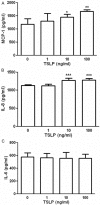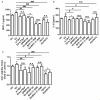TSLP induced by estrogen stimulates secretion of MCP-1 and IL-8 and growth of human endometrial stromal cells through JNK and NF-κB signal pathways
- PMID: 24966899
- PMCID: PMC4069968
TSLP induced by estrogen stimulates secretion of MCP-1 and IL-8 and growth of human endometrial stromal cells through JNK and NF-κB signal pathways
Abstract
It has reported that human endometrial stromal cells (ESCs) express thymic stromal lymphopoietin (TSLP), and TSLP concentrations in the serum and peritoneal fluid were higher in women with endometriosis. Endometriosis is an estrogen-dependent disease. The present study aimed to elucidate whether and how estrogen regulates the growth of ESCs through TSLP. The ESCs behaviors in vitro were verified by SRB assay and Ki67 level detection, respectively. In addition, the effects of estrogen on TSLP and TSLP on the correspondent functional molecules were investigated by ELISA and flow cytometry. Here we found that estrogen stimulated the secretion of TSLP in a dosage-dependent manner. Recombinant human TSLP stimulates the secretion of MCP-1 and IL-8, and markedly promotes the viability and proliferation relative gene Ki-67 expression of ESCs. These effects could be abolished by the inhibitor for JNK or NF-κB signal, respectively. Moreover, not only anti-TSLP neutralizing antibody, but also blocking JNK or NF-κB signal by inhibitor abrogated the stimulatory role in the production of MCP-1 and IL-8, and the growth of ESCs induced by estrogen. Our current study has demonstrated that TSLP is involved in the regulation of estrogen on the secretion of MCP-1 and IL-8, and the growth of ESCs through JNK and NF-κB signal pathways, which suggests that the abnormal high expression of TSLP induced by estrogen may play an important role in ESCs growth and finally contribute to the origin and development of endometriosis.
Keywords: ESCs; IL-8; MCP-1; TSLP; endometriosis; estrogen; proliferation.
Figures







Similar articles
-
IL-22 in the endometriotic milieu promotes the proliferation of endometrial stromal cells via stimulating the secretion of CCL2 and IL-8.Int J Clin Exp Pathol. 2013 Sep 15;6(10):2011-20. eCollection 2013. Int J Clin Exp Pathol. 2013. PMID: 24133578 Free PMC article.
-
Interleukin-1β stimulates the secretion of thymic stromal lymphopoietin (TSLP) from endometrioma stromal cells: possible involvement of TSLP in endometriosis.Hum Reprod. 2012 Oct;27(10):3028-35. doi: 10.1093/humrep/des291. Epub 2012 Aug 11. Hum Reprod. 2012. PMID: 22888172
-
Chemokine CCL2 enhances survival and invasiveness of endometrial stromal cells in an autocrine manner by activating Akt and MAPK/Erk1/2 signal pathway.Fertil Steril. 2012 Apr;97(4):919-29. doi: 10.1016/j.fertnstert.2011.12.049. Epub 2012 Jan 20. Fertil Steril. 2012. PMID: 22265030
-
Anti-inflammatory cytokines in endometriosis.Cell Mol Life Sci. 2019 Jun;76(11):2111-2132. doi: 10.1007/s00018-019-03056-x. Epub 2019 Mar 2. Cell Mol Life Sci. 2019. PMID: 30826860 Free PMC article. Review.
-
Effects of TSLP on obstetrical and gynecological diseases.Am J Reprod Immunol. 2017 Jan;77(1). doi: 10.1111/aji.12612. Epub 2016 Dec 15. Am J Reprod Immunol. 2017. PMID: 27976427 Review.
Cited by
-
Estrogen restricts the apoptosis of endometrial stromal cells by promoting TSLP secretion.Mol Med Rep. 2018 Nov;18(5):4410-4416. doi: 10.3892/mmr.2018.9428. Epub 2018 Aug 24. Mol Med Rep. 2018. PMID: 30152851 Free PMC article.
-
Thymic stromal lymphopoietin participates in the host response to intra-amniotic inflammation leading to preterm labor and birth.Hum Immunol. 2023 Sep;84(9):450-463. doi: 10.1016/j.humimm.2023.06.005. Epub 2023 Jul 6. Hum Immunol. 2023. PMID: 37422429 Free PMC article.
-
Sex difference in EGFR pathways in mouse kidney-potential impact on the immune system.BMC Genet. 2016 Nov 24;17(1):146. doi: 10.1186/s12863-016-0449-3. BMC Genet. 2016. PMID: 27881077 Free PMC article.
-
Transcription factor addictions: exploring the potential Achilles' Heel of endometriosis.Sci China Life Sci. 2025 Aug;68(8):2277-2289. doi: 10.1007/s11427-024-2832-8. Epub 2025 Mar 27. Sci China Life Sci. 2025. PMID: 40163264 Review.
-
Pharmaceuticals targeting signaling pathways of endometriosis as potential new medical treatment: A review.Med Res Rev. 2021 Jul;41(4):2489-2564. doi: 10.1002/med.21802. Epub 2021 May 5. Med Res Rev. 2021. PMID: 33948974 Free PMC article.
References
-
- Bulun SE. Endometriosis. N Engl J Med. 2009;360:268–279. - PubMed
-
- Baldi A, Campioni M, Signorile PG. Endometriosis: pathogenesis, diagnosis, therapy and association with cancer (review) Oncol Rep. 2008;19:843–846. - PubMed
-
- Ulukus M, Cakmak H, Arici A. The role of endometrium in endometriosis. J Soc Gynecol Investing. 2006;13:467–476. - PubMed
-
- Barrier BF. Immunology of endometriosis. Clin Obstet Gynecol. 2010;53:397–402. - PubMed
-
- Rizner TL. Estrogen metabolism and action in endometriosis. Mol Cell Endocrinol. 2009;307:8–18. - PubMed
Publication types
MeSH terms
Substances
LinkOut - more resources
Full Text Sources
Medical
Research Materials
Miscellaneous
